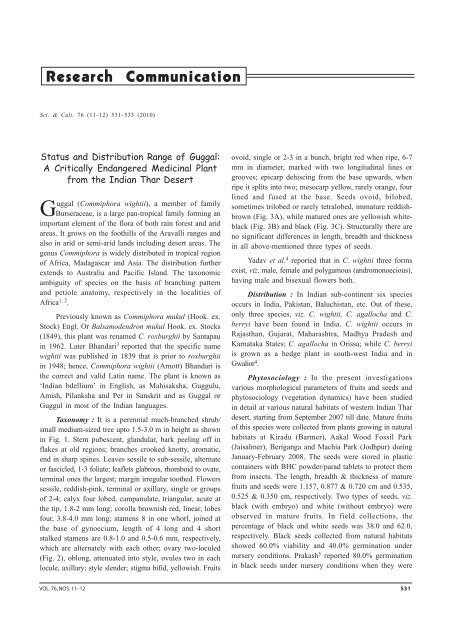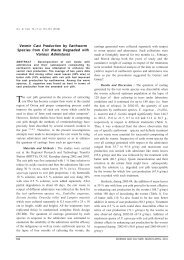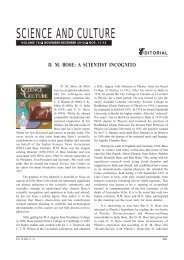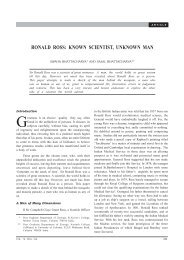A Critically Endangered Medicinal Plant from the Indian Thar Desert
A Critically Endangered Medicinal Plant from the Indian Thar Desert
A Critically Endangered Medicinal Plant from the Indian Thar Desert
Create successful ePaper yourself
Turn your PDF publications into a flip-book with our unique Google optimized e-Paper software.
Research CommunicationSci. & Cult. 76 (11–12) 531–533 (2010)Status and Distribution Range of Guggal:A <strong>Critically</strong> <strong>Endangered</strong> <strong>Medicinal</strong> <strong>Plant</strong><strong>from</strong> <strong>the</strong> <strong>Indian</strong> <strong>Thar</strong> <strong>Desert</strong>Guggal (Commiphora wightii), a member of familyBurseraceae, is a large pan-tropical family forming animportant element of <strong>the</strong> flora of both rain forest and aridareas. It grows on <strong>the</strong> foothills of <strong>the</strong> Aravalli ranges andalso in arid or semi-arid lands including desert areas. Thegenus Commiphora is widely distributed in tropical regionof Africa, Madagascar and Asia. The distribution fur<strong>the</strong>rextends to Australia and Pacific Island. The taxonomicambiguity of species on <strong>the</strong> basis of branching patternand petiole anatomy, respectively in <strong>the</strong> localities ofAfrica 1, 2 .Previously known as Commiphora mukul (Hook. ex.Stock) Engl. Or Balsamodendron mukul Hook. ex. Stocks(1849), this plant was renamed C. roxburghii by Santapauin 1962. Later Bhandari 3 reported that <strong>the</strong> specific namewightii was published in 1839 that is prior to roxburghiiin 1948; hence, Commiphora wightii (Arnott) Bhandari is<strong>the</strong> correct and valid Latin name. The plant is known as‘<strong>Indian</strong> bdellium’ in English, as Mahisaksha, Guggulu,Amish, Pilanksha and Per in Sanskrit and as Guggal orGuggul in most of <strong>the</strong> <strong>Indian</strong> languages.Taxonomy : It is a perennial much-branched shrub/small medium-sized tree upto 1.5-3.0 m in height as shownin Fig. 1. Stem pubescent, glandular, bark peeling off inflakes at old regions; branches crooked knotty, aromatic,end in sharp spines. Leaves sessile to sub-sessile, alternateor fascicled, 1-3 foliate; leaflets glabrous, rhomboid to ovate,terminal ones <strong>the</strong> largest; margin irregular too<strong>the</strong>d. Flowerssessile, reddish-pink, terminal or axillary, single or groupsof 2-4; calyx four lobed, campanulate, triangular, acute at<strong>the</strong> tip, 1.8-2 mm long; corolla brownish red, linear, lobesfour, 3.8-4.0 mm long; stamens 8 in one whorl, joined at<strong>the</strong> base of gynoecium, length of 4 long and 4 shortstalked stamens are 0.8-1.0 and 0.5-0.6 mm, respectively,which are alternately with each o<strong>the</strong>r; ovary two-loculed(Fig. 2), oblong, attenuated into style, ovules two in eachlocule, axillary; style slender; stigma bifid, yellowish. Fruitsovoid, single or 2-3 in a bunch, bright red when ripe, 6-7mm in diameter, marked with two longitudinal lines orgrooves; epicarp dehiscing <strong>from</strong> <strong>the</strong> base upwards, whenripe it splits into two; mesocarp yellow, rarely orange, fourlined and fused at <strong>the</strong> base. Seeds ovoid, bilobed,sometimes trilobed or rarely tetralobed, immature reddishbrown(Fig. 3A), while matured ones are yellowish whiteblack(Fig. 3B) and black (Fig. 3C). Structurally <strong>the</strong>re areno significant differences in length, breadth and thicknessin all above-mentioned three types of seeds.Yadav et al. 4 reported that in C. wightii three formsexist, viz. male, female and polygamous (andromonoecious),having male and bisexual flowers both.Distribution : In <strong>Indian</strong> sub-continent six speciesoccurs in India, Pakistan, Baluchistan, etc. Out of <strong>the</strong>se,only three species, viz. C. wightii, C. agallocha and C.berryi have been found in India. C. wightii occurs inRajasthan, Gujarat, Maharashtra, Madhya Pradesh andKarnataka States; C. agallocha in Orissa; while C. berryiis grown as a hedge plant in south-west India and inGwalior 4 .Phytosociology : In <strong>the</strong> present investigationsvarious morphological parameters of fruits and seeds andphytosociology (vegetation dynamics) have been studiedin detail at various natural habitats of western <strong>Indian</strong> <strong>Thar</strong>desert, starting <strong>from</strong> September 2007 till date. Mature fruitsof this species were collected <strong>from</strong> plants growing in naturalhabitats at Kiradu (Barmer), Aakal Wood Fossil Park(Jaisalmer), Beriganga and Machia Park (Jodhpur) duringJanuary-February 2008. The seeds were stored in plasticcontainers with BHC powder/parad tablets to protect <strong>the</strong>m<strong>from</strong> insects. The length, breadth & thickness of maturefruits and seeds were 1.157, 0.877 & 0.720 cm and 0.535,0.525 & 0.350 cm, respectively. Two types of seeds, viz.black (with embryo) and white (without embryo) wereobserved in mature fruits. In field collections, <strong>the</strong>percentage of black and white seeds was 38.0 and 62.0,respectively. Black seeds collected <strong>from</strong> natural habitatsshowed 60.0% viability and 40.0% germination undernursery conditions. Prakash 5 reported 80.0% germinationin black seeds under nursery conditions when <strong>the</strong>y wereVOL. 76, NOS. 11–12 531
sown during March in 1:1:1 soil mixture ratio of sand: clay:FYM.According to Prakash et al. 6 in C. wightii, a seedproduces more than one seedling due to its polyembryonicnature. They fur<strong>the</strong>r stated that out of <strong>the</strong> total germinatedseeds, nearly 58.6% seeds produced one seedling per seed,27.6% produced two seedlings per seed, 10.3% producedthree seedlings per seed and 3.4% produced four seedlingsper seed.Phytosociological studies at different localities of <strong>the</strong><strong>Indian</strong> <strong>Thar</strong> desert revealed that Euphorbia caducifolia,Salvadora oleoides, Ziziphus nummularia, Grewia tenax,Capparis decidua, Acacia senegal, Maytenus emarginata,Asparagus racemosus, Aristolochia bracteolata, Prosopiscineraria, Solanum torum, Rhynchosia minima, etc. aresome of <strong>the</strong> species which are associated with it in naturalhabitats. Data fur<strong>the</strong>r showed that E. caducifolia isabundant with this species in natural population except atAakal Wood Fossil Park research site, where A. senegaland S. oleoides were dominated. The maximum ImportantValue Index (IVI; %) values of C. wightii and E. caducifoliawere 72.49 and 38.54, respectively at various research sites.In <strong>Indian</strong> arid zone, edaphic factors play <strong>the</strong> mostimportant part and <strong>the</strong> plant associations are in relation to<strong>the</strong> habitat, though some plants have <strong>the</strong> potentiality ofgrowing in a limited range of environmental conditions 7 .Utility and Conservation Status : Guggal-gum istraditionally used by ethnic tribes as well as in Ayurvedasystem of medicines for centuries in <strong>the</strong> treatment ofobesity, arthritis, hyperlipidemia, thrombosis, inflammatory,antimicrobial, etc. The gum resin is a complex mixture ofsteroids, diterpenoides, aliphatic esters, carbohydrates andvariety of inorganic ions, which are present in ‘Balsamcanal’ in <strong>the</strong> phloem of larger veins of <strong>the</strong> leaf and <strong>the</strong>soft bast of stem. The price of guggal gum over last 10-15years have increased <strong>from</strong> Rs. 100-400 kg -1 indicating manyfold increase in its use as well as decrease in natural plantstand and is considered as a threatened one in India andincluded in <strong>the</strong> Red Data Book of IUCN 8 . Presently, in <strong>the</strong>different localities of <strong>the</strong> <strong>Indian</strong> <strong>Thar</strong> desert, this speciesshow declining populations as well as in gum productionlevel in natural habitats every year. Kasera and Prakash 9reported that due to changes in climatic conditions, soilerosion, low rainfall, termite infestation, over-grazing bydomestic animals and mining activities have created anincreased pressure on <strong>the</strong> environment and existing naturalpopulations of this species. So, <strong>the</strong> mass destruction ofpopulation and poor regeneration in changed situationshas reduced <strong>the</strong> vegetation cover. Fur<strong>the</strong>r, non-survival ofFigures: Commiphora wightii plant growing in natural habitat(1), T.S. of ovary showing three rudimentary and one developedovules (2), and variability in seed colour: A - reddish-brown, B -black & white, & C - black (3).532 SCIENCE AND CULTURE, NOVEMBER-DECEMBER, 2010
<strong>the</strong> plants after tapping and gum extraction is a major setback to plant stands in natural habitats. Now, UNDP havelisted this species as a ‘<strong>Critically</strong> <strong>Endangered</strong>’ and itsconservation status is CR A2cd, 4cd 10 .Future Needs : During our field observations wefound that this species is under higher risk for survival innatural habitats with prevailing changing environmentscenario. The basic and most important tasks to conserveand develop techniques for cultivation of this species are:(i) survey, germplasm collection and evaluation <strong>from</strong>different ecological habitats and systematic verification, (ii)refinement in tapping techniques of gum collection atoptimum commercial production level without harming <strong>the</strong>plants for future gum production and extraction, and (iii)to develop agro techniques for large scale plantation, sothat <strong>the</strong> growing demand for gum-resin by user industriesis fulfilled in near future.AcknowledgementsThe first author is thankful to <strong>the</strong> UGC, New Delhi(No. F. 17-78/98(SA-I) dated 15.2.2008) for financialassistance in <strong>the</strong> form of NET-JRF. Thanks to <strong>the</strong> Professor& Head, Department of Botany, J.N.V. University, Jodhpurfor providing facilities.HEERA LAL ANDPAWAN K. KASERA*Laboratory of <strong>Plant</strong> Ecology,Department of BotanyJai Narain Vyas University,Jodhpur 342 033, India*Corresponding authorE-mail: jnvupkkasera@yahoo.co.inReceived : 14 August, 2009Revised : 16 June, 20101M. Thomasson, Bull. de Ia Societe Botanique de, 119: 207-213 (1972).2J. J. A. Van der Walt and H. P. Van der Schijff, Kirika, 9: 95-108 (1973).3M. M. Bhandari, Bull. Bot. Surv. India, 6: 327-328 (1964).4B.B.L. Yadav, K.V. Billore, T.G. Joseph and D.D. Chatturvedi,Cultivation of Guggulu, CCRAS, New Delhi, pp. 94.5J. Prakash, Ph.D. Thesis, JN Vyas University, Jodhpur (2001).6J. Prakash, P. K. Kasera and D. D. Chawan, Curr. Sci., 78:1185-1187 (2000).7D.N. Sen, Trop. Ecol. 7: 136-152 (1966).8S. Natesh and H. Y. Mohan Ram, J. <strong>Indian</strong> bot. Soc., 78: 13-23 (1999).9P.K. Kasera and J. Prakash, in: Recent Progress in <strong>Medicinal</strong><strong>Plant</strong>s: <strong>Plant</strong> Bioactives in Traditional Medicine, (edsMajumdar, D. K., Govil, J.N., Singh, V. K. and Sharma, R.K.),Vol. 9, pp. 403-423 (2005) (Studium Press LLC, USA).10UNDP, Rajasthan Red Listed <strong>Medicinal</strong> <strong>Plant</strong>s, 2008, pp. 22-23, http://www. frlht.org.VOL. 76, NOS. 11–12 533





